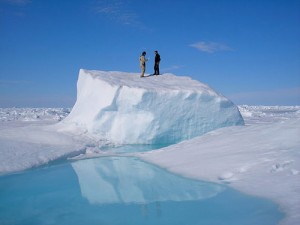Sea ice study goes beyond the numbers
July 28, 2011
907-474-7468
7/28/2011
In places where the air gets cold enough to freeze seawater, sea ice creates a world known by few people. A shifting, ephemeral, both jagged and smooth platform of white that clings to the shore for much of the year. In Barrow, people who hunt whales start packing down snowmachine trails over this blue-white dreamscape in March. The trails allow a few dozen crews to pursue and hopefully winch home a few bowhead whales in April and May.

Like most college students, Matt Druckenmiller did not know much about sea ice when he began his degree program but now he has walked and snowmachined whalerŌĆÖs trails to the ice edge near Barrow, earning a doctorate and getting to know people who harvest bowhead whales along the way.
A few weeks ago, Druckenmiller defended his thesis at ąįė¹╔ń. He described the last couple of years in which he made detailed maps of whalerŌĆÖs snowmachine trails across sea ice, creating something local people found useful while also getting detailed information on thickness and the curious nature of landfast formations.
ŌĆ£Once they saw a product, they loved it,ŌĆØ said the Barrow Arctic Science ConsortiumŌĆÖs Glenn Sheehan of DruckenmillerŌĆÖs maps that showed the paths of whaling crews squiggling from town to the edge of the sea ice. ŌĆ£Whenever hunters would see them, theyŌĆÖd always stop and talk about them.ŌĆØ
As he created the maps by walking or snowmachining trails with a GPS, Druckenmiller had time to appreciate how different life is in the far north.
ŌĆ£It really is a dangerous and committing venture to be camped miles offshore in such dynamic (ice) conditions,ŌĆØ Druckenmiller said in an e-mail after he defended his thesis. ŌĆ£These hunters are truly sea ice experts, but not simply because of ┼Ætraditional knowledge.ŌĆÖ Their ingenuity in dealing with such a harsh and variable environment also plays an important role in their hunting success.ŌĆØ
DruckenmillerŌĆÖs research is a rare combination of hard science and listening. He found himself interviewing hunters over cups of coffee and spending hours on the ice with them, hacking trails though ridges, or just absorbing their words. When he first flew to Barrow, Druckenmiller was intimidated at the prospect of working with locals.
ŌĆ£I was never quite sure how they might view a migratory graduate student driving around on their ice trails measuring thickness,ŌĆØ Druckenmiller said. ŌĆ£But after a few years, it became clear that, by and large, they appreciated the work I was doing, especially since I produced usable maps for the whaling crews during the hunting season. Also, after a while, you get to know individuals and the whole effort becomes much more personal, more meaningful.ŌĆØ
Craig George is a researcher who also grew up outside the Inupiat culture but who has lived in Barrow for decades, becoming one of the worldŌĆÖs few experts on bowhead whales. He was impressed with DruckenmillerŌĆÖs efforts, which he hopes will continue.
ŌĆ£The bottom line is trust (from the locals),ŌĆØ George said. ŌĆ£And in MattŌĆÖs case, some brains and toughness.ŌĆØ
ŌĆ£He listens a lot,ŌĆØ said Lewis Brower, a lifelong Barrow resident who is on a whaling crew and is station manager for the Barrow Arctic Science Consortium.
ŌĆ£WeŌĆÖve gotten to know each other over the years,ŌĆØ Brower said. ŌĆ£HeŌĆÖs become more of a friend than a scientist. HeŌĆÖs really one of those guys that makes projects worth reoccurring. There should be more people like him.ŌĆØ
This column is provided as a public service by the Geophysical Institute at the University of Alaska Fairbanks, in cooperation with the ąįė¹╔ń research community. Ned Rozell is a science writer at the institute.


